Vegetables to plant in August: 10 crops to sow and grow this month
We reveal the best vegetables to plant in August, so you can enjoy kohlrabi, beetroot, spinach and more
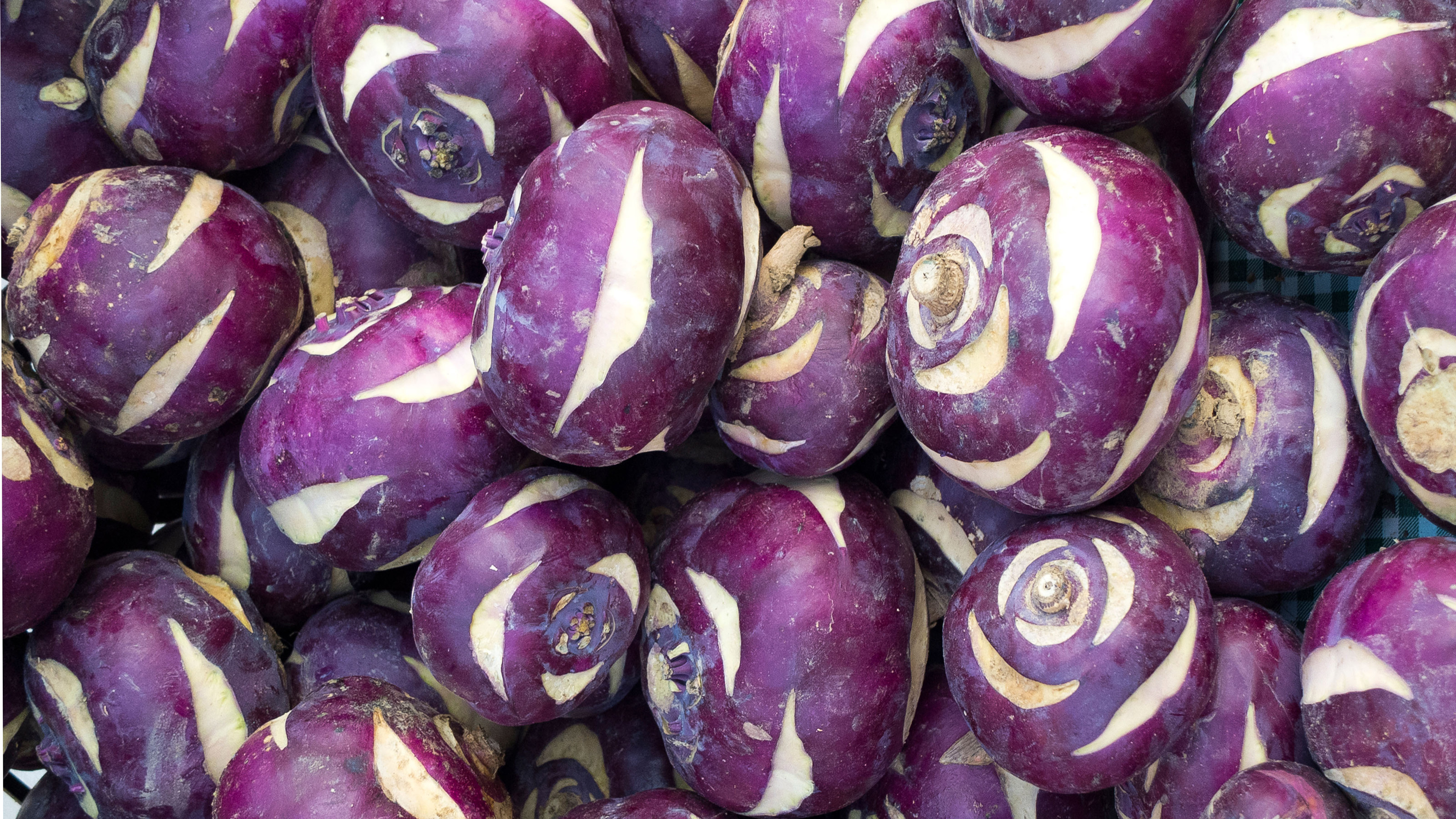

Knowing the best vegetables to plant in August gives you a golden opportunity to raise your gardening game even as gaps are appearing from early summer harvests. You may have been reaping the rewards of earlier seasonal labors, but there is plenty more veggie goodness to be had if you get stuck into some late summer sowings. And as well as making the most of any bare patches that are popping up in your kitchen garden, August sowings set you up nicely for quick-maturing fall feasts and slower-developing crops to be enjoyed for months to come.
‘There’s no doubt that spring is the main sowing period, but high summer is a close second,’ says Amateur Gardening’s Lucy Chamberlain. And depending on where you live, that could mean between eight and 10 weeks where night-time temperatures remain in double figures.
This point in the vegetable planting calendar combines warm soil conditions with cool outdoor opportunities and optimal hydration. Choose the right crops, make some successive sowings, and you could be feasting on these August plantings well into winter, and beyond.
Use containers, cold frames and cloches to eke every inch of growing space out of your August sowings. Our selection of yummy roots and leafy treats, traditional classics and modern beauties are guaranteed to help you squeeze even more gardening goodness out of your plot. So what are you waiting for? Let’s get growing…
10 vegetables to plant in August for weeks of tasty bounty
The best vegetables to plant in August combine quick-maturing exotics like choy sum, tatsoi and mizuna (Oriental leaves) with slower-developing favorites like leeks, as well as some unusual and quirky croppers like red orache and purple kohlrabi.
Whether your tastes run to the traditional or the international, you’re sure to find something here to complement your raised garden bed ideas and container gardening schemes. So take advantage of the warm, sunny days left and plant some of these veggies for plentiful harvests ahead!
1. Red orache
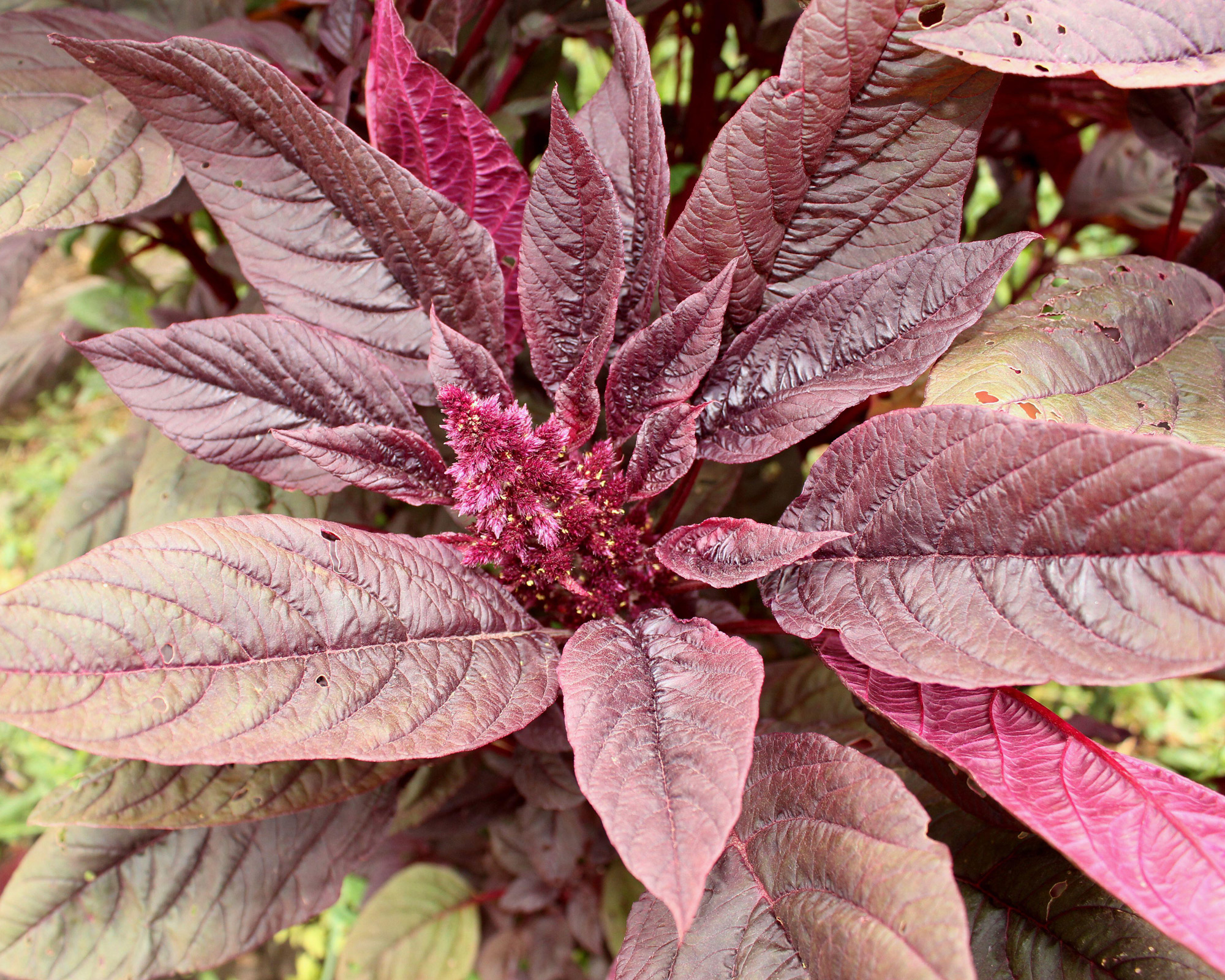
Vibrant, eye-catching and easy on the eye, the first of our vegetables to plant in August is as ornamental as it is tasty. Red orache is also easy to grow, adaptable to a range of growing conditions and highly nutritious.
Known as ‘the new kale’, this superfood is charmingly down to earth, with a heritage that dates back to the Middle Ages. And as Amateur Gardening’s Lucy Chamberlain points out, it works hard. 'While the Latin name is a mouthful (Atriplex hortensis var. rubra), that’s nothing compared to the abundant pickings it gives you,' says Lucy.
High summer sowings are ideal for this hardy annual. It loves late season sunshine, grows quickly and is undeterred by drops in temperature. Sow in situ every three weeks, wherever you see gaps. These crops thrive in full sun and partial shade in moist, well-drained soils. They also do well in salty soil, making attractive coastal plants and drought resistant garden ideas, and even work well in pots. Orache is a great companion plant for spinach and also makes one of the best companion plants for kale and other brassicas, as well as peas, eggplants, beans and leeks.
Thin seedlings to 10in (25cm), then just wait for those hot red harvests. Eat leaves and stems raw while young (they are stunning in salads), or cook older crops in soups, quiches and pies.
Pinch for continued leaf growth – the gorgeous ‘mountain spinach’ keeps cropping until a heavy frost. And if you let one plant flower and self-seed in late summer, you will ensure years of yummy interest.
2. Purple kohlrabi

Kohlrabi (German turnip) is one of the more unusual brassicas. If you know how to grow cabbage, cauliflower or kale, it’s time to broaden your horizons with one of the most visually intriguing vegetables to plant in August.
With a taste and texture that’s a cross between broccoli and water chestnut, quirky kohlrabi (Brassica oleracea var. gongylodes) is peppery and sweet. Roughly translating as ‘turnip cabbage’, it fuses both in one vegetable, with long leafy limbs draped around a swollen stem.
While green varieties are best sown in late spring, purple varieties are best sown as summer nears a close. That way, seedlings make the most of the warm soil while mature plants relish temperate fall weather.
As organic garden expert Bob Flowerdew points out, kohlrabi enjoys an early phase of warmth followed by cool conditions for ripening. Great purples include succulent ‘Kolibri’, bolt-resistant ‘Azur Star’, heirloom ‘Blauer Speck’ and tender ‘Purple Vienna’.
They make good companion plants for cucumbers and nasturtiums, and if you like growing radishes you’ll have no problems with these brassicas.
These alien-style beasts are happy growing in light, free-draining soil. Sow direct in drills 0.5in (1cm) deep and thin seedlings to 10in (25cm) apart, then water and weed until crops swell. Harvest while young as they turn woody if left too long.
Raw or cooked, kohlrabi is rich in vitamin C and A, potassium, iron and calcium, so it’s great for boosting bone density, regulating blood pressure and improving eye health.
3. Oriental leaves
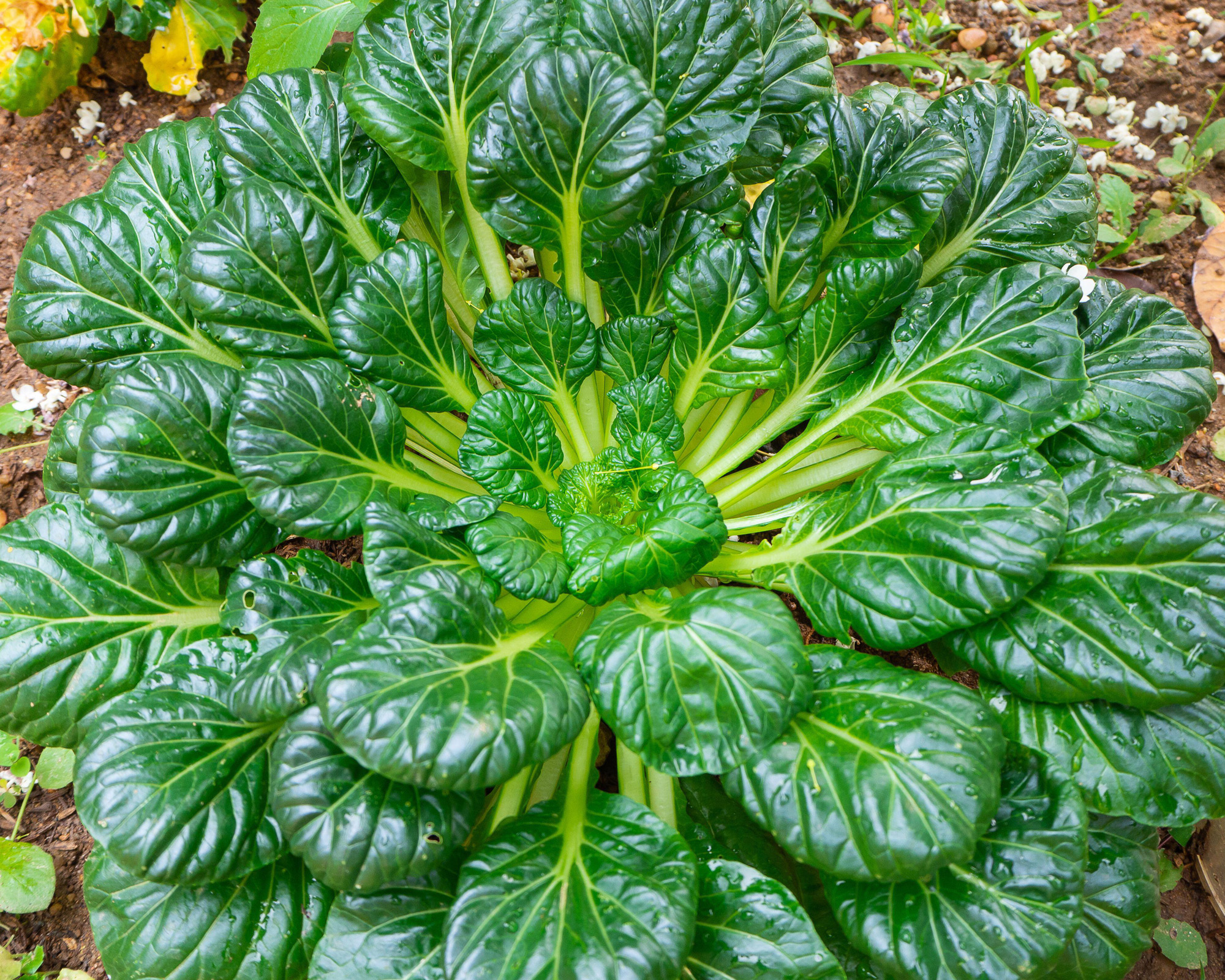
Chinese cabbage, choy sum, mizuna, mibuna, mustard greens, tatsoi, komatsuna: the choice of Oriental salads is endless. They make ideal options for late summer sowings in the kitchen garden as they like to germinate in warm soil but thrive in the damp conditions of the fall and they bulk up quickly from seed. What’s more, leafy Asian vegetables create a diverse and appetizing array of colors and textures.
As Lucy Chamberlain notes, their rapid growth means they fill that gap when traditional summer veggies have finished cropping, yet winter crops have still to harvest. If you want the easiest vegetables to grow now, these exotic leafy stalwarts are a must.
Make light sowings in moist soil, then cover with cloches for lush vegetation. Alternatively, grow in large shallow containers. Sow every few weeks in 2-3m drills, thinning once large enough. Then keep well watered for full freshness and crispness.
Oriental leaves make great companion plants for broccoli, and if you like to grow Brussels sprouts these are effective for interplanting.
Baby leaves can be harvested in 40 days. Using the come-again-cut-again method, you can encourage more growth for months. Enjoy young, or saute older wilted leaves. Start with bottom leaves, always leaving two thirds of foliage. If you want seeds, leave some crops to flower.
4. Swiss chard

Leaf beet, as it is also known, is a member of the ‘goosefoot’ family. It’s easy to grow, packed with vitamins, and lovely in floral garden borders or large containers. One sowing gives months of crops. Eat young leaves (and stalks) raw, or use established leaves in stir-fries, casseroles and soups. Great varieties to try include vibrant ‘Bright Lights’, chunky ‘Bright Yellow’, scarlet ‘Fantasy’ and creamy ‘Fordhook Giant’.
Chard is one of the best companion plants for garlic and grows well with root vegetables like parsnips and turnips. If you know how to grow lavender it is also worth adding some of this alongside chard as it helps with productivity.
Leaf beets prefers moderate temperatures as heat slows down growth. Just make a shallow drill in free-draining soil in an open, sunny site. Sow thinly, around half an inch (1.5cm) deep, in rows 15in (40cm) apart. Cover with soil and water well. Thin to 12in (30cm) apart, or 2in (5cm) for mini crops. Water well and add mulch to hold in moisture.
These joyfully tinted plants are visually arresting as well as nutritious, and make some of the most colorful additions to a small vegetable garden or allotment. They are ready to harvest 10-12 weeks after sowing. In mid fall, cover plants with cloches or protect with straw.
5. Baby carrots
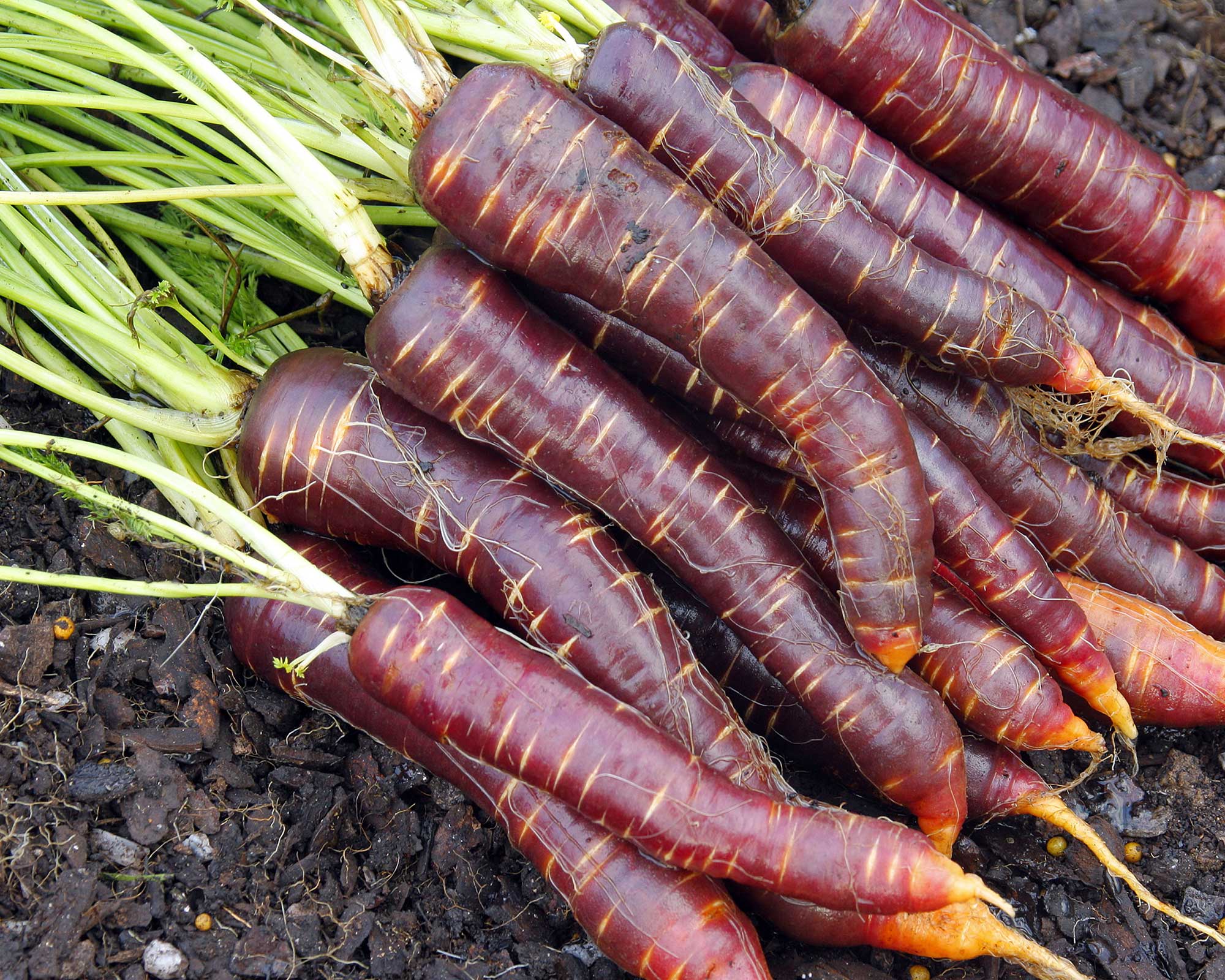
Not thought about how to grow carrots yet this year? Don't worry as you’ve still got a tiny bit of time left to start off mini-sized hunks of homegrown loveliness to enjoy in cooler months. ‘These crunchy roots take time to bulk up, so sow now if you’d like abundant winter casseroles, soups and roasts,’ says Lucy Chamberlain. Choose an open, sunny spot and you’re all set. Celery, parsnips and lettuce are the best companion plants for carrots, and herbs like sage and rosemary also make excellent planting partners.
Here are Lucy’s easy three-step guide to the best baby carrots:
- Fork in a base dressing of bone meal or similar slow-release fertilizer before raking over the area to level it and remove larger stones. This is important because carrots struggle with stones.
- Make your drill slightly deeper than normal (1.5-2in or 4-5cm is good) to combat any summer drought. Water the base thoroughly, then sprinkle the carrot seeds between finger and thumb to space them 0.2in (0.5cm) apart. This allows for germination failures and you can thin out the surplus later.
- Cloak sowings in insect-proof mesh to protect against root fly. Keep well weeded and watered, and wait for those yummy crunchers!
Choose an appropriate winter-hardy variety. Lucy recommends ‘Extremo’ and ‘Eskimo’. We also love ‘Purple Haze’, the first hybrid colored carrot with purple skin and orange insides.
6. Spinach
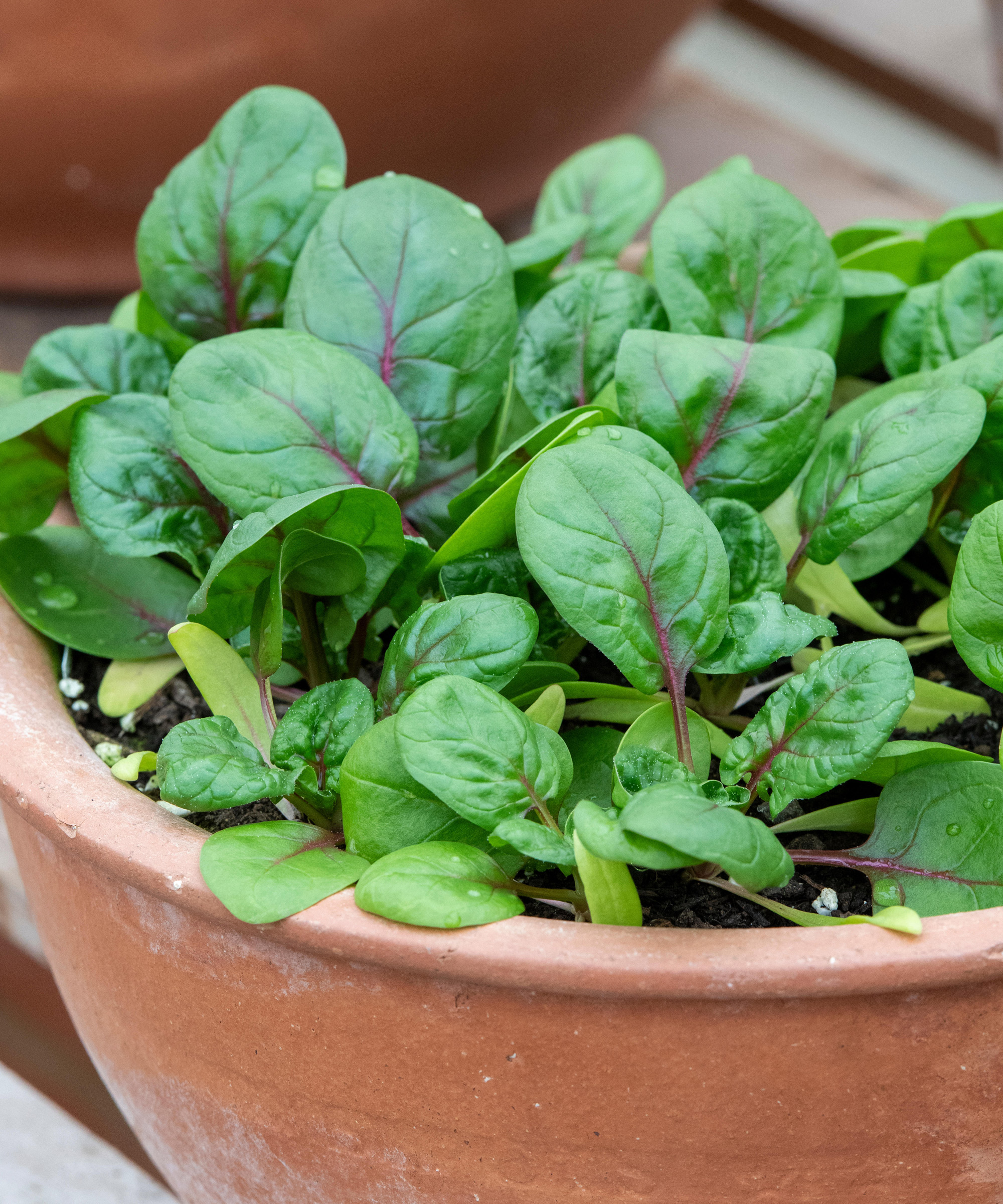
Popeye’s crop of choice, spinach is a nutritious staple and if you follow our guide on how to grow spinach you'll soon see it's oh-so easy to grow too. It should definitely be on your list of vegetables to plant in August, as you can reap the rewards well into winter if you choose a hardy cultivar and select a sunny spot. It’s great as baby leaves for crunchy salads or as larger, fatter additions to the soup or casserole pot.
After prepping the soil with some aged garden compost or organic material, direct-sow in a drill 1in (2.5cm) deep. If sowing multiple rows, space 1ft (30cm) apart. Water, then cover lightly with soil. Thin to 4-6in (10-15cm) apart. Then keep well watered. You can also sow seeds thinly in large containers. In hot spells, make sure the plants benefit from some shade. For productive companion planting, you will find that growing with French beans or runner beans works well. Spinach is also one of the best companion plants for tomatoes and works well with strawberries, too.
Good varieties include ‘Perpetual Spinach’, which does well on dry soils, crunchy ‘Medania’ and fast-growing ‘Missouri’. For a decorative flourish, try ‘Red Veined’. If you need resistance to downy mildew, try ‘Apollo’ or ‘Palco’. For resistance to bolting, try ‘Violin’ and ‘Amazon’. Ensure good plant spacing to improve air circulation, and keep watering the base of the plants. Six-10 weeks later, harvest every alternate plant. Cut back to just above the base of the plant to encourage more leaves.
7. Baby beetroot
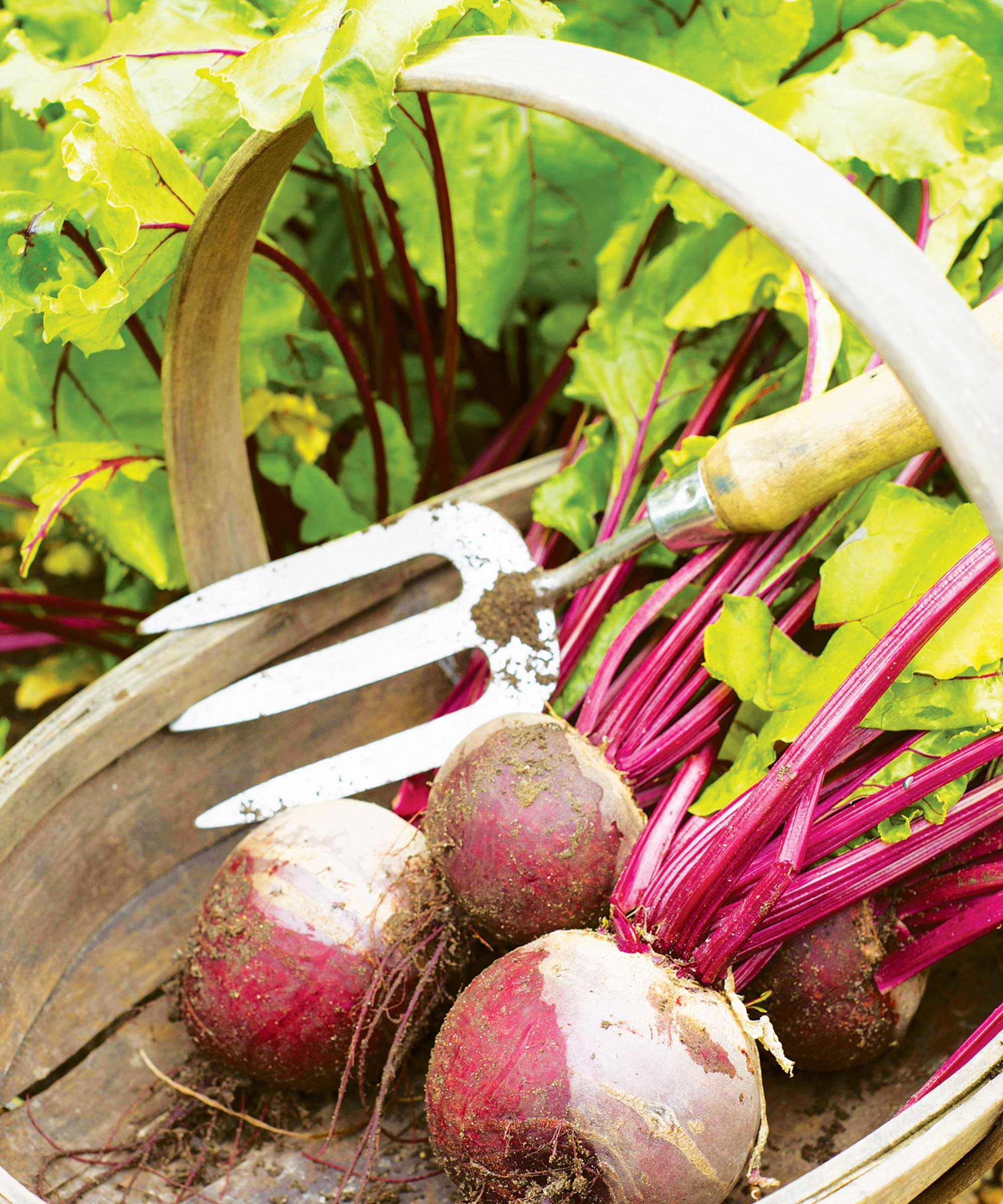
As well as being easy and full of color options, beetroot is one of those veggies that tastes amazing when young. So capitalize on the next few weeks of sunshine to cultivate baby roots that are mouthwatering even when no bigger than golf ball size! Beetroot is one of the best plants for beginners, so take advantage of this opportunity to start off some beet beauties of your own. Beets can be harvested until mid fall, and their storage potential means you can be chomping on roots well into winter.
Bear the following tips in mind when starting out with how to grow beetroot.
- You need fertile, well-drained soil that’s been raked to a fine tilth. Before sowing, add some well-rotted garden compost or similar organic matter. Also rake in a handful of general-purpose fertilizer.
- Sow three seeds at 4in (10cm) spacings, an inch deep (2.5cm) deep, with rows a foot (30cm) apart. Make sure the spot is sunny and warm.
- When seedlings are an inch (2.5cm) high, thin to 4in (10cm) spacings.
- During dry spells, watering plants every week is a must (it reduces the risk of bolting as well as nourishing your beets). It might help to apply a high nitrogen fertilizer and water this in.
- At harvest, lift a few alternate roots by gathering the base of the stems and twisting, or lift with a fork. Although especially tender if harvested young, they are fine eaten when the size of a tennis ball or smaller.
Beetroots make some of the best companion plants for onions, as well as thriving alongside beans, cabbage and lettuce, Some beet varieties, like F1 hybrid ‘Action’ are bred to quickly give tender, baby roots and they have bolt-resistance too, says Lucy. Then there’s purple 'Boltardy’ for early cropping, ‘Pablo’ for lip-smacking baby beets, pink and white 'Chioggia’ and sunny 'Burpee’s Golden’.
8. Parsley
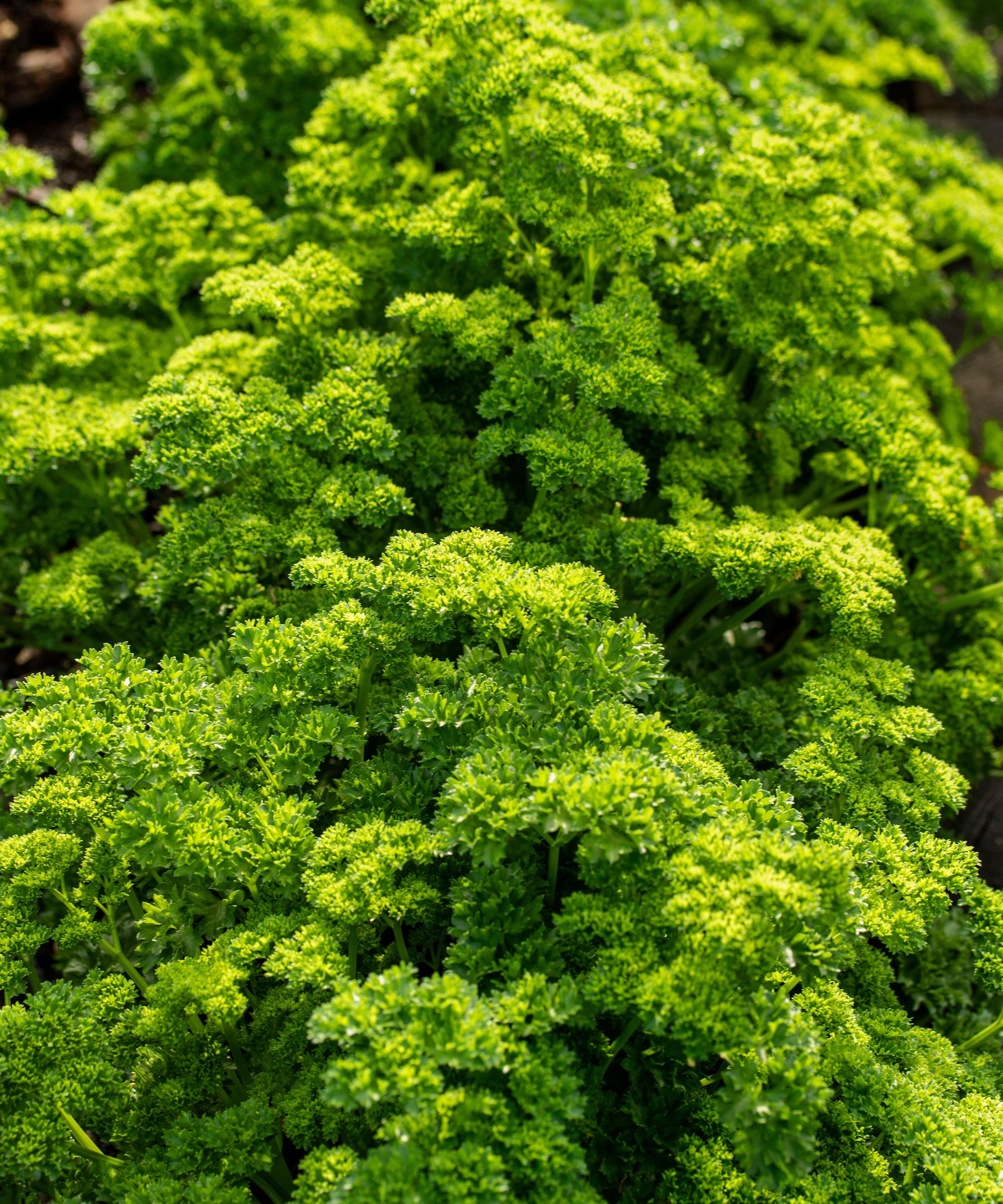
Parsley is a perfect addition to all kinds of herb garden ideas and you can choose from pretty curly-leaf varieties like ‘Envy AGM’ and ‘Champion Moss Curled’ or the stronger flat-leaf type like ‘Titan’ and ‘Gigante Napoletano’.
To grow parsley with real staying power, sow seeds indoors from August to March in cells or plug trays, or in pots. It is slow to germinate, taking six weeks, so make sure growing conditions are warm. Lightly cover with more compost and keep moist. Grow on in cooler conditions and plant out when the last frosts are over, after hardening off for 10 days.
Alternatively, buy young plants to plant out in late summer. Apply a granular plant food and water in dry periods to prevent bolting. It helps to add a liquid feed such as seaweed fertilizer. Harvest when the plant has 10 leaves, and cover with a cloche to protect from cold and extend the harvest season.
Parsley is one of the best low maintenance plants you can grow. Just cover sowings with a cloche, and use garlic and onions as companion planting options to deter pests like carrot root fly. Celery leaf miner can also be a problem, so grow under horticultural fleece or mesh for the best results.
9. Leeks
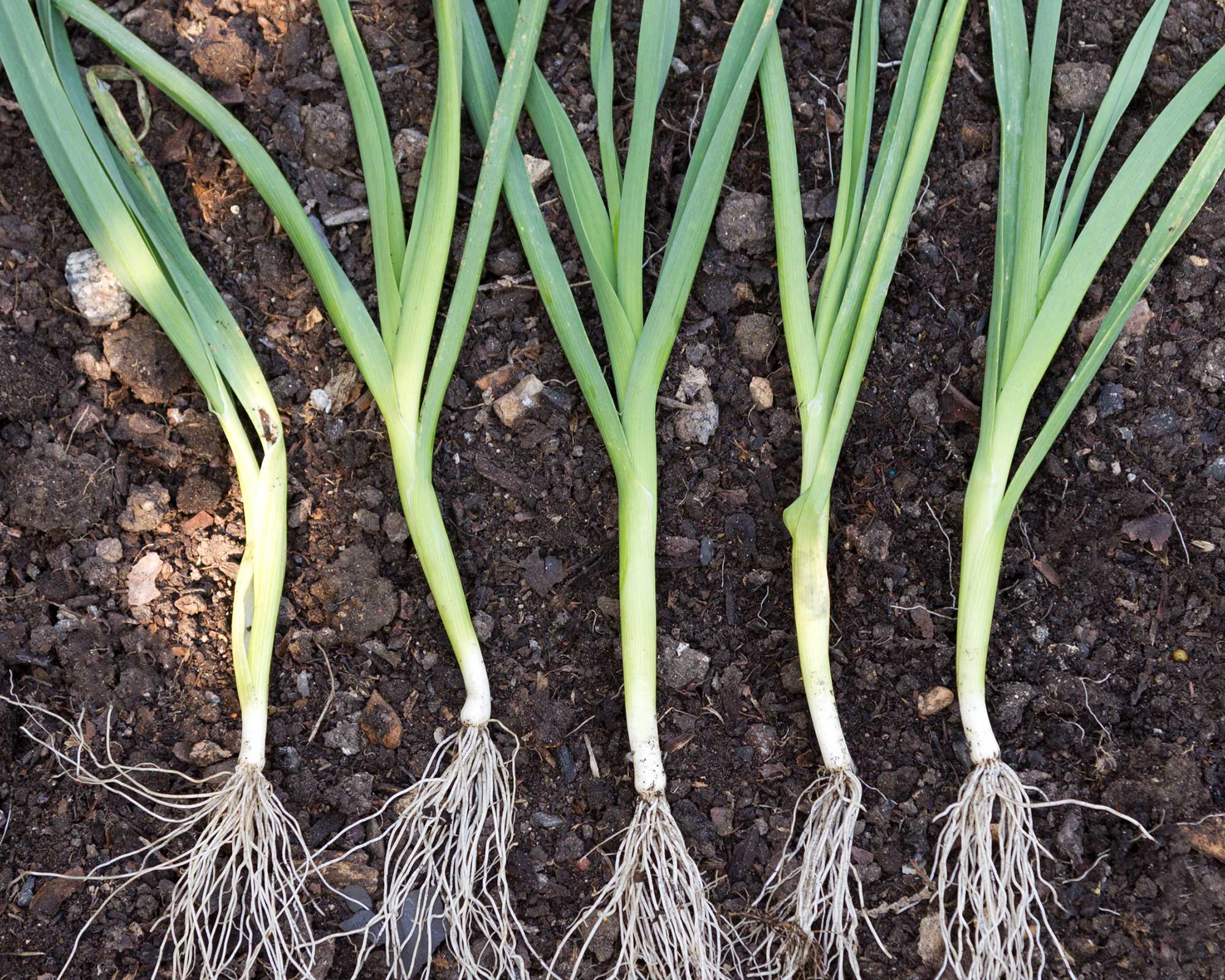
Homegrown leeks are a lush, sweet treat that are rich in vitamin A. And if you are keen to grow leeks, August is a great time to plant them in their final positions. Seedlings started in April-May (indoors or in a seed bed) will develop strong roots at the 10-week mark. Once they are pencil-thick, they are good to transplant. Make planting holes 6in (15cm) deep. A good guide is two-thirds underground and one third above soil level. Plant 8-12in (20-30cm) apart and remember to water the hole (known as puddling in).
Once more of each leek plant is showing above soil level, you can ‘blanch’ your leeks to improve the flavour. Draw the soil up the stem as it grows, or tie cardboard tubes around stems. Also, don’t forget to water during long, dry spells and weed regularly.
Leeks are members of the family known as alliums and are best grown in a place that didn't have onions or garlic the previous year. Apart from that, leeks are delightfully low maintenance.
They take 25-40 weeks to fully harvest, depending on the variety and growing conditions. Good late-maturing varieties include 'Blauwgroene Winter Bandit' and ‘Porbella’.
10. Claytonia

Claytonia perfoliata (aka miner’s lettuce or winter purslane) is quick growing, mild and rich in vitamin C. This hardy leaf was widely used in the California Goldrush and was known as the food to eat ‘when times are tough’. It’s a forager’s favorite and it thrives even in poor, light soils. It's a fantastic salad option if you are looking for leafy crops to grow into the fall. If you are keen on growing lettuce in winter, you will also find this gem can be sown successively over several months for crunchy cool harvests.
Follow these top tips for great results.
- Choose a slightly shaded site for shallow drills, and water plants well before sowing. Sow half an inch deep in rows, then thin so they are 3-4in (8-10cm) apart.
- Sow in August, or plant between August and September, then harvest from October to February. This plant is ready to harvest six-eight weeks after sowing.
- Cut leaves as soon as they are large enough. Harvest until the plant starts to flower the following February. It can self-seed quickly, but seedlings can be removed easily.
Try growing with a frilly leaf rocket, deep purple Chinese basil or red orache. As well as being packed with vitamin C, this lovely plant is loaded with iron, magnesium and calcium, and is high in omega-3 fatty acids.
Prepare a drill in hot, dry weather
Make sure you prepare the groundwork well for your August sowings. Lucy Chamberlain explains how to give your crops the best start:
- Make your drill deeper than normal, so instead of the usual 2in (5cm) opt for 3in (8cm). By burying the seeds deeper in the soil you’ll protect them from drying out, leading to better germination and emergence.
- Once excavated, irrigate the drill thoroughly. Apply half a watering can to a 2m-long drill, adding it in stages so that it soaks in well. You’re then creating a water reservoir for your young seedlings to tap into.
- Cover over the drill with dry soil, tamping it down well with the back of a rake to eliminate air pockets. By keeping this top layer dry rather than wet, the moisture doesn’t wick to the surface and evaporate away.
It’s also a good idea to make sure your growing area is well prepared by following our tips on how to get rid of weeds. Hopefully we’ve given you plenty to be getting on with this month with these vegetables to plant in August. Happy growing – and don’t forget to fill up your watering cans and water your growing crops every day over the late summer weeks!


As assistant editor of Amateur Gardening magazine, Janey's gardening passion was fostered from an early age, when her amazing mum had her deadheading hydrangeas, mulching roses, and propagating strawberry plants from runners for school open days. She's also taken part in lots of conservation and rewilding projects for the RHS and TCV as a way of exploring her horticultural horizons.
